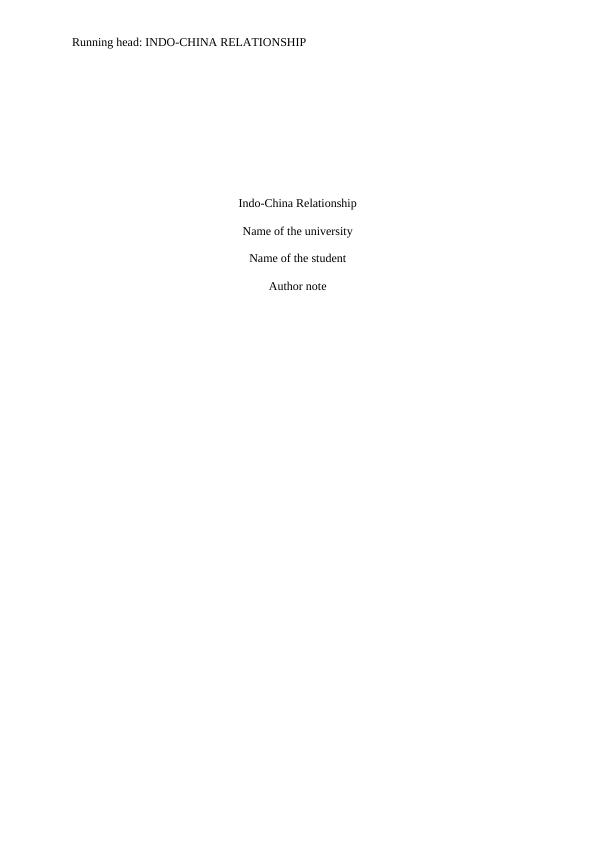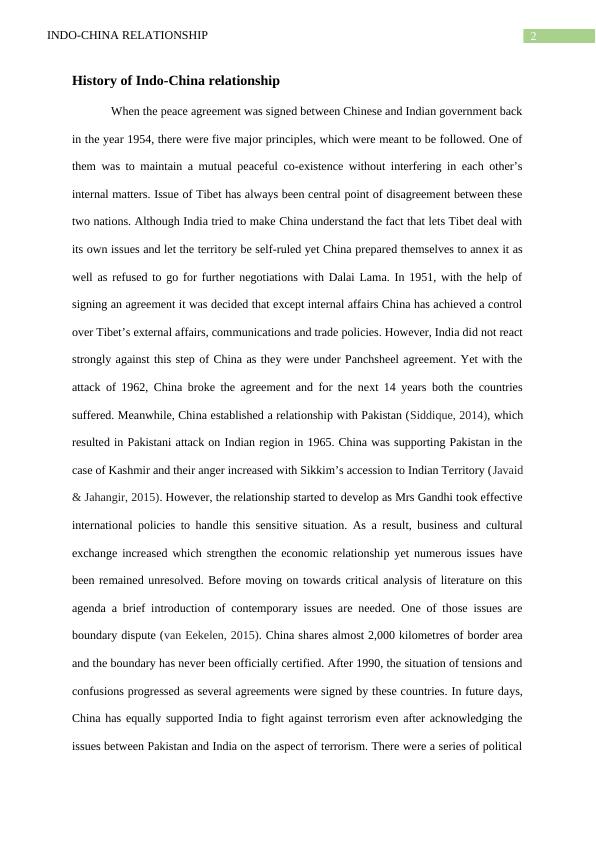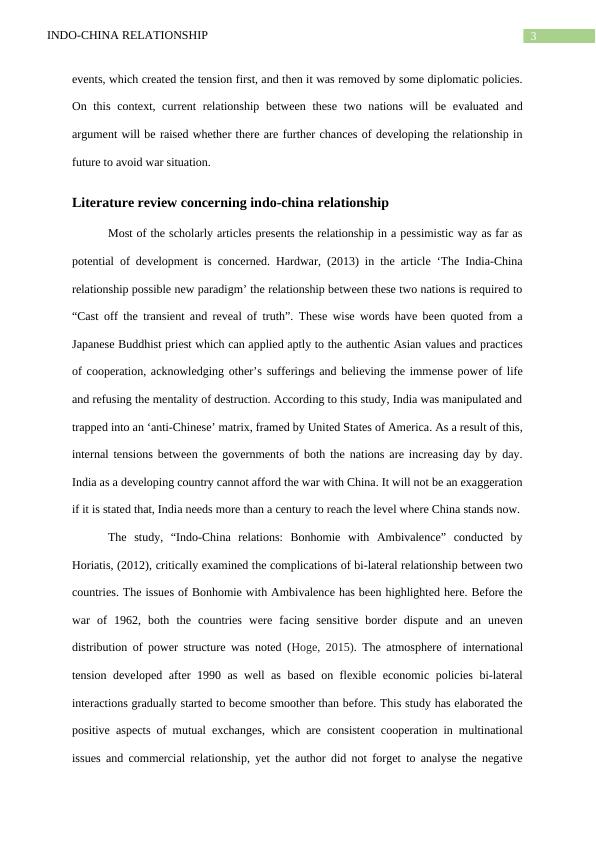Indo-China Relationship: History, Literature Review, and Future Prospects
Added on 2023-06-10
14 Pages4295 Words456 Views
Running head: INDO-CHINA RELATIONSHIP
Indo-China Relationship
Name of the university
Name of the student
Author note
Indo-China Relationship
Name of the university
Name of the student
Author note

1INDO-CHINA RELATIONSHIP
Introduction
The purpose of this paper is to present the current relationship between India and
china and the way it has been evolving since the year of 1950. Since the ancient period,
Chinese travellers and a huge number of Chinese students used to visit Nalanda University in
Bihar, India. India was the first country to establish political relationship with China in 1950.
Prime Minister Nehru’s visit to china in the year of 1954 confirmed an agreement of
maintaining mutual peace termed as Panchsheel, which was consisted of five principles.
However, the agreement did not last as China attacked India in 1962. Although, after 14 years
both signed the peace agreement again yet these two countries do not share a pleasant
relationship in contemporary times (MAHBUBANI, Jing & BAJPAI, 2015). Various tensions
are going on between these two countries starting from political and international boundaries
to trade and cultural issues. At first, this paper will discuss the history of events, which will
clarify the reasons behind the deterioration (Rao, 2014). With the help of few academic
journals, further dimensions are going to be added to this topic. Afterwards, this analysis will
raise an argument whether the internal matters can be resolved and a fresh start can be
initiated or not. There is a high possibility of deterioration as China maintains a bond with
Pakistan consistently (Ahmed et al., 2016). On the other hand, trade can be considered as one
of the biggest factors working as a bridge between two countries. Both the nations are
dependent on each other in terms of investment and business exchanges (Afsharipour &
Rana, 2013). Moreover, a steady growth in both the economies has been noticed in past ten
years. Still, the fact cannot be denied that the relationship has always been complicated and
controversial as well. The central argument revolves around whether these nations can work
towards the development of interpersonal relationship.
Introduction
The purpose of this paper is to present the current relationship between India and
china and the way it has been evolving since the year of 1950. Since the ancient period,
Chinese travellers and a huge number of Chinese students used to visit Nalanda University in
Bihar, India. India was the first country to establish political relationship with China in 1950.
Prime Minister Nehru’s visit to china in the year of 1954 confirmed an agreement of
maintaining mutual peace termed as Panchsheel, which was consisted of five principles.
However, the agreement did not last as China attacked India in 1962. Although, after 14 years
both signed the peace agreement again yet these two countries do not share a pleasant
relationship in contemporary times (MAHBUBANI, Jing & BAJPAI, 2015). Various tensions
are going on between these two countries starting from political and international boundaries
to trade and cultural issues. At first, this paper will discuss the history of events, which will
clarify the reasons behind the deterioration (Rao, 2014). With the help of few academic
journals, further dimensions are going to be added to this topic. Afterwards, this analysis will
raise an argument whether the internal matters can be resolved and a fresh start can be
initiated or not. There is a high possibility of deterioration as China maintains a bond with
Pakistan consistently (Ahmed et al., 2016). On the other hand, trade can be considered as one
of the biggest factors working as a bridge between two countries. Both the nations are
dependent on each other in terms of investment and business exchanges (Afsharipour &
Rana, 2013). Moreover, a steady growth in both the economies has been noticed in past ten
years. Still, the fact cannot be denied that the relationship has always been complicated and
controversial as well. The central argument revolves around whether these nations can work
towards the development of interpersonal relationship.

2INDO-CHINA RELATIONSHIP
History of Indo-China relationship
When the peace agreement was signed between Chinese and Indian government back
in the year 1954, there were five major principles, which were meant to be followed. One of
them was to maintain a mutual peaceful co-existence without interfering in each other’s
internal matters. Issue of Tibet has always been central point of disagreement between these
two nations. Although India tried to make China understand the fact that lets Tibet deal with
its own issues and let the territory be self-ruled yet China prepared themselves to annex it as
well as refused to go for further negotiations with Dalai Lama. In 1951, with the help of
signing an agreement it was decided that except internal affairs China has achieved a control
over Tibet’s external affairs, communications and trade policies. However, India did not react
strongly against this step of China as they were under Panchsheel agreement. Yet with the
attack of 1962, China broke the agreement and for the next 14 years both the countries
suffered. Meanwhile, China established a relationship with Pakistan (Siddique, 2014), which
resulted in Pakistani attack on Indian region in 1965. China was supporting Pakistan in the
case of Kashmir and their anger increased with Sikkim’s accession to Indian Territory (Javaid
& Jahangir, 2015). However, the relationship started to develop as Mrs Gandhi took effective
international policies to handle this sensitive situation. As a result, business and cultural
exchange increased which strengthen the economic relationship yet numerous issues have
been remained unresolved. Before moving on towards critical analysis of literature on this
agenda a brief introduction of contemporary issues are needed. One of those issues are
boundary dispute (van Eekelen, 2015). China shares almost 2,000 kilometres of border area
and the boundary has never been officially certified. After 1990, the situation of tensions and
confusions progressed as several agreements were signed by these countries. In future days,
China has equally supported India to fight against terrorism even after acknowledging the
issues between Pakistan and India on the aspect of terrorism. There were a series of political
History of Indo-China relationship
When the peace agreement was signed between Chinese and Indian government back
in the year 1954, there were five major principles, which were meant to be followed. One of
them was to maintain a mutual peaceful co-existence without interfering in each other’s
internal matters. Issue of Tibet has always been central point of disagreement between these
two nations. Although India tried to make China understand the fact that lets Tibet deal with
its own issues and let the territory be self-ruled yet China prepared themselves to annex it as
well as refused to go for further negotiations with Dalai Lama. In 1951, with the help of
signing an agreement it was decided that except internal affairs China has achieved a control
over Tibet’s external affairs, communications and trade policies. However, India did not react
strongly against this step of China as they were under Panchsheel agreement. Yet with the
attack of 1962, China broke the agreement and for the next 14 years both the countries
suffered. Meanwhile, China established a relationship with Pakistan (Siddique, 2014), which
resulted in Pakistani attack on Indian region in 1965. China was supporting Pakistan in the
case of Kashmir and their anger increased with Sikkim’s accession to Indian Territory (Javaid
& Jahangir, 2015). However, the relationship started to develop as Mrs Gandhi took effective
international policies to handle this sensitive situation. As a result, business and cultural
exchange increased which strengthen the economic relationship yet numerous issues have
been remained unresolved. Before moving on towards critical analysis of literature on this
agenda a brief introduction of contemporary issues are needed. One of those issues are
boundary dispute (van Eekelen, 2015). China shares almost 2,000 kilometres of border area
and the boundary has never been officially certified. After 1990, the situation of tensions and
confusions progressed as several agreements were signed by these countries. In future days,
China has equally supported India to fight against terrorism even after acknowledging the
issues between Pakistan and India on the aspect of terrorism. There were a series of political

3INDO-CHINA RELATIONSHIP
events, which created the tension first, and then it was removed by some diplomatic policies.
On this context, current relationship between these two nations will be evaluated and
argument will be raised whether there are further chances of developing the relationship in
future to avoid war situation.
Literature review concerning indo-china relationship
Most of the scholarly articles presents the relationship in a pessimistic way as far as
potential of development is concerned. Hardwar, (2013) in the article ‘The India-China
relationship possible new paradigm’ the relationship between these two nations is required to
“Cast off the transient and reveal of truth”. These wise words have been quoted from a
Japanese Buddhist priest which can applied aptly to the authentic Asian values and practices
of cooperation, acknowledging other’s sufferings and believing the immense power of life
and refusing the mentality of destruction. According to this study, India was manipulated and
trapped into an ‘anti-Chinese’ matrix, framed by United States of America. As a result of this,
internal tensions between the governments of both the nations are increasing day by day.
India as a developing country cannot afford the war with China. It will not be an exaggeration
if it is stated that, India needs more than a century to reach the level where China stands now.
The study, “Indo-China relations: Bonhomie with Ambivalence” conducted by
Horiatis, (2012), critically examined the complications of bi-lateral relationship between two
countries. The issues of Bonhomie with Ambivalence has been highlighted here. Before the
war of 1962, both the countries were facing sensitive border dispute and an uneven
distribution of power structure was noted (Hoge, 2015). The atmosphere of international
tension developed after 1990 as well as based on flexible economic policies bi-lateral
interactions gradually started to become smoother than before. This study has elaborated the
positive aspects of mutual exchanges, which are consistent cooperation in multinational
issues and commercial relationship, yet the author did not forget to analyse the negative
events, which created the tension first, and then it was removed by some diplomatic policies.
On this context, current relationship between these two nations will be evaluated and
argument will be raised whether there are further chances of developing the relationship in
future to avoid war situation.
Literature review concerning indo-china relationship
Most of the scholarly articles presents the relationship in a pessimistic way as far as
potential of development is concerned. Hardwar, (2013) in the article ‘The India-China
relationship possible new paradigm’ the relationship between these two nations is required to
“Cast off the transient and reveal of truth”. These wise words have been quoted from a
Japanese Buddhist priest which can applied aptly to the authentic Asian values and practices
of cooperation, acknowledging other’s sufferings and believing the immense power of life
and refusing the mentality of destruction. According to this study, India was manipulated and
trapped into an ‘anti-Chinese’ matrix, framed by United States of America. As a result of this,
internal tensions between the governments of both the nations are increasing day by day.
India as a developing country cannot afford the war with China. It will not be an exaggeration
if it is stated that, India needs more than a century to reach the level where China stands now.
The study, “Indo-China relations: Bonhomie with Ambivalence” conducted by
Horiatis, (2012), critically examined the complications of bi-lateral relationship between two
countries. The issues of Bonhomie with Ambivalence has been highlighted here. Before the
war of 1962, both the countries were facing sensitive border dispute and an uneven
distribution of power structure was noted (Hoge, 2015). The atmosphere of international
tension developed after 1990 as well as based on flexible economic policies bi-lateral
interactions gradually started to become smoother than before. This study has elaborated the
positive aspects of mutual exchanges, which are consistent cooperation in multinational
issues and commercial relationship, yet the author did not forget to analyse the negative

End of preview
Want to access all the pages? Upload your documents or become a member.
Related Documents
The Conflict and Negotiationlg...
|5
|1394
|15
The Origins and Causes of the Cold War: A Historical Perspectivelg...
|5
|1037
|407
Essay on International Business (New Zealand vs China)lg...
|12
|4119
|799
